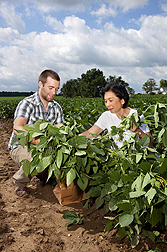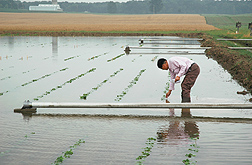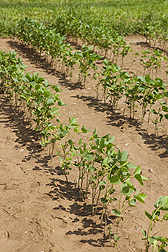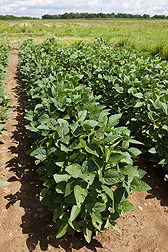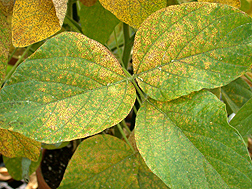Searching for Genes To Protect
Soybeans From Flooding and Diseases
|
|
Soybean varieties that grow in rice paddies in Southeast Asia could provide the United States with much-needed genes for developing soybeans tolerant to flooding—as well as to root rot and other plant diseases found in waterlogged soils.
Tara VanToai pursued the genes for these traits. She recently retired from the Agricultural Research Service’s Soil Drainage Research Unit in Columbus, Ohio.
VanToai worked with plant pathologist Anne Dorrance and soybean breeders Grover Shannon and Henry Nguyen in the search for genes that protect against both flooding and plant diseases. Dorrance is at Ohio State University’s Ohio Agricultural Research and Development Center in Wooster; Shannon and Nguyen are at the University of Missouri, in Portageville and Columbia, respectively.
The team works on multiple fronts, including molecular plant breeding, with the help of DNA markers, genetic transformation, and soil management—all in an effort to protect soybeans growing on wet soils.
Flooding—Vietnam to Ohio
Growing up in the Mekong Delta of Vietnam, and then working in Ohio, VanToai has experienced firsthand the harm flooding does to crop yields. VanToai has been studying flood tolerance in soybeans for more than two decades, in greenhouse, lab, and growth-chamber conditions as well as in experimental and farm fields in Ohio and in Missouri. She has also studied and collected soybean lines in Vietnam and China, including backyard soybean plants that survived China’s 1991 flood-of-the-century. The series of research studies is being funded by ARS, the U.S. Department of Agriculture’s Foreign Agricultural Service, the United Soybean Board, and the North Central Soybean Research Program.
She has also collaborated with scientists from Brazil, China, France, and Hungary, as well as Vietnam.
|
|
U.S. Soybeans Need New Genes
VanToai and colleagues need to incorporate genes from plants native to other countries to supplement the narrow genetic base of U.S. soybeans and to improve tolerance to wet soil and associated diseases.
The varieties of soybeans used by most American farmers are damaged by even short periods in waterlogged soil. Yield losses as high as 25 percent are estimated in the Mississippi Delta region, Asia, and other regions of the world where soybean crops are rotated with paddy rice. The losses are from injuries due to flooding and flood irrigation.
Tests of 21 soybean varieties in flooded experimental fields at Can Tho, Vietnam, revealed three lines of soybean—VND2, Nam Vang, and ATF15-1—with superior flood tolerance.
VanToai and the team did this research with Tran Thi Cuc Hoa and Nguyen Thi Ngoc Hue—both with the Mekong Delta Rice Research Institute, where the experiments were done.
Soybean Plants with Superior Flood Tolerance
Plants from the three flood-tolerant lines grew tallest and had the biggest seeds and the highest yields.
|
|
The 21 lines tested included plants native to Vietnam and Cambodia and those developed through selection by farmers and gardeners. They also included lines developed by modern breeding practices and imported from Australia, China, Japan, and Taiwan.
Nam Vang is native to Cambodia, while VND2 and ATF15-1 are from China and Australia, respectively. The initial experiments were done in outdoor “screenhouses,” which are greenhouses with screens instead of glass. VanToai found that the screenhouses, while not completely duplicating field results, allowed for accurate predictions of flood tolerance in soybeans.
Flood-tolerance is defined as the ability of a plant to survive 10 days of steady flooding during the plant’s critical flowering stage.
For the screenhouse tests, the plants were grown in pots. When each plant was in full bloom, it was placed for 2 weeks in a bucket of water so that the water level was 2 inches above the soil surface.
In later field tests, the plants were subjected for 2 weeks to water 4 to 6 inches above the soil surface.
The screenhouse tests killed up to 100 percent of susceptible varieties. The test accurately identified the top three flood-tolerant lines, later borne out by the flooded-field tests.
|
|
Soybean Secrets
VanToai has also analyzed flood-tolerant eastern gamagrass in the United States for its secrets, one of which turned out to be aerenchyma. This is tissue with air channels that enable roots of plants—rice, for example—to grow under water. These open channels allow flooded roots to snorkel air from the above-water parts of the plants. ARS scientists and university breeders have introduced aerenchyma into wheat and corn experimentally.
VanToai found that soybean plants that survive flooding use some of the same mechanisms as rice growing in paddies.
The two standbys that rice roots rely on for its ability to grow in water are adventitious roots and aerenchyma. Adventitious roots grow out of the plant’s stem near the soil surface. They work in tandem with aerenchyma to provide even more oxygen to flooded roots.
Genes for Flood Survival
The scientists are looking for genes that trigger the development of those two standbys, as well as other flood-tolerant aids.
|
|
They found that flood-tolerant soybean lines develop more adventitious roots and more aerenchyma than flood-susceptible lines. Some soybean lines developed adventitious roots as early as 2 days after being flooded. They discovered that a flood-tolerant South Korean variety, PI 408105A, showed only a 30-percent yield reduction after 10 days of flooding during the critical flowering stage, while the susceptible U.S. variety S99-2281 lost more than 80 percent of its yield. The scientists crossed PI 408105A with S99-2281 to study and transfer the resistance genes.
They evaluated 200 lines from these crosses in fields in Ohio and Missouri for 2 years and identified several lines with a consistent tolerance to flooding.
DNA markers were found that could effectively identify plants that carried the resistance genes. Clear genetic differences were found between the roots of flood-tolerant and flood-susceptible plants.
Because the parents PI 408105A and S99-2281 also show differences in resistance to soybean root and stem rot diseases, Dorrance used the same 200 lines of the population to look for genes for root rot resistance.
Are Flood- and Root Rot-Resistance Genes the Same?
“Now we’re wondering whether root rot was contributing to the yield reductions we saw in susceptible plants,” VanToai says. “Did the tolerant plants do so much better because they were tolerant not only of flooding but also of root rot? Are some of the same genes involved?” VanToai wonders.
She and colleagues have mapped the genes and found that there is an overlap of genes for resistance to flooding and wet-soil-borne diseases, which indicates some genes are involved in both, while others are not.
Several of the plant lines VanToai and colleagues have developed over the years are included in the ARS Soybean Germplasm Collection in Urbana, Illinois.—By Don Comis, formerly with ARS.
This research is part of Water Availability and Watershed Management (#211), Plant Genetic Resources, Genomics, and Genetic Improvement (#301), and Plant Biological and Molecular Processes (#302), three ARS national programs described at www.nps.ars.usda.gov.
To reach scientists mentioned in this article, contact Robert Sowers, USDA-ARS Information Staff, 5601 Sunnyside Ave., Beltsville, MD 20705-5129; (301) 504-1651.
|
|
Asian soybean rust, a major disease of soybeans worldwide, was found in soybean fields in South America in 2000. It was first found in the continental United States 4 years later—most likely its spores delivered by winds of an unusually busy hurricane season.
From 2006 to 2009, ARS plant pathologists Tara VanToai (retired), at Columbus, Ohio, and Glen Hartman, at Urbana, Illinois, and other colleagues at the University of Illinois at Urbana and the University of Missouri at Columbia collaborated with scientists at the Plant Protection Research Institute and the Thai Nguyen Education University in Hanoi, Vietnam, to test 65 soybean varieties for resistance to soybean rust. These varieties included rust-resistant accessions from the USDA Soybean Germplasm Collection identified in earlier research, resistant varieties from the Vietnam collection, and susceptible checks. In all, she and colleagues found that the Vietnamese soybean variety DT 2000 showed the strongest resistance in all five experiments. Response of varieties with known resistance genes varied from experiment to experiment.
Asian soybean rust is constantly forming new strains. “This means that we need to develop standardized ‘tester’ strains so that we can compare results across studies,” VanToai says.
The next step will be to identify and map the resistance genes present in the resistant variety found in the Vietnam study and determine their effectiveness against specific soybean rust strains.
VanToai says that the rust-resistant soybean varieties from Vietnam may have genes that could be helpful wherever rust strains have a similar virulence to those in Vietnam.—By Don Comis, formerly with ARS.
"Searching for Genes To Protect Soybeans From Flooding and Diseases" was published in the July 2012 issue of Agricultural Research magazine.







